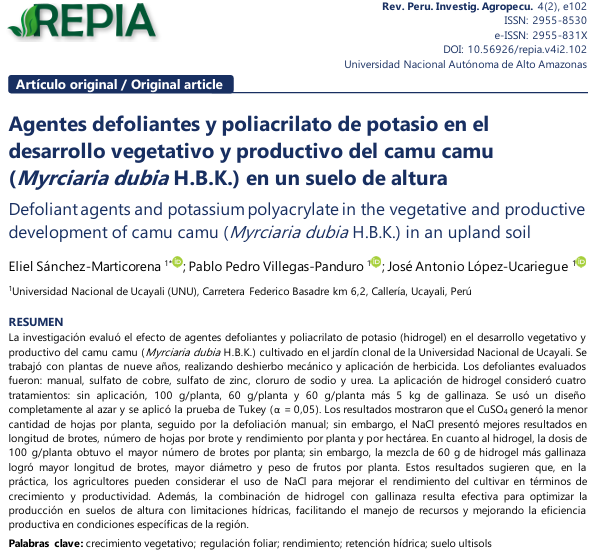Defoliant agents and potassium polyacrylate in the vegetative and productive development of camu camu (Myrciaria dubia H.B.K.) in an upland soil
DOI:
https://doi.org/10.56926/repia.v4i2.102Keywords:
vegetative growth, foliar regulation, yield, water retention, ultisols soilAbstract
The study evaluated the effect of defoliant agents and potassium polyacrylate (hydrogel) on the vegetative and productive development of camu camu (Myrciaria dubia H.B.K.) cultivated in the clonal garden of the National University of Ucayali. Nine-year-old plants were used, with mechanical weeding and herbicide application. The defoliants assessed were: manual defoliation, copper sulfate, zinc sulfate, sodium chloride, and urea. Hydrogel application included four treatments: no application, 100 g/plant, 60 g/plant, and 60 g/plant plus 5 kg of poultry manure. A completely randomized design was employed, and Tukey’s test (α = 0.05) was applied. Results showed that CuSO4 produced the fewest leaves per plant, followed by manual defoliation; however, NaCl achieved better results in shoot length, number of leaves per shoot, and yield per plant and per hectare. Regarding hydrogel, the 100 g/plant dose resulted in the highest number of shoots per plant; nevertheless, the combination of 60 g hydrogel plus poultry manure produced greater shoot length, larger fruit diameter, and higher fruit weight per plant. These results suggest that, in agricultural practice, farmers can consider using NaCl to improve camu camu performance in terms of growth and productivity. Furthermore, combining hydrogel with chicken manure represents an effective strategy for optimizing production in high-altitude soils with water limitations, facilitating resource management and improving productive efficiency under specific regional conditions.
Downloads
References
Abanto, C., Sánchez Choy, J., Saldaña, W., Paifa, M., & Alves Chagas, E. (2011). Efecto de la altura de poda de formación en la arquitectura de plantas de camu camu (Myrciaria dubia H.B.K. Mc Vaugh) en la estación experimental del IIAP, Ucayali, Perú. Scientia Agropecuaria, 2(2), 73–81. https://doi.org/10.17268/sci.agropecu.2011.02.02 DOI: https://doi.org/10.17268/sci.agropecu.2011.02.02
Abanto Rodríguez, C. (2010). Efecto del fertirriego sobre la productividad del camu camu (Myrciaria dubia H.B.K. Mc Vaugh) en la Región de Ucayali [Tesis de licenciatura, Universidad Nacional Agraria La Molina]. https://repositorio.lamolina.edu.pe/handle/20.500.12996/1685
ABC de Sevilla. (2023). Todo lo que necesitas saber a la hora de aplicar defoliantes al algodón. Recuperado de https://sevilla.abc.es/agronoma/noticias/cultivos/algodon/aplicacion-defoliantes-algodon-raif/
Agriplant Growth. (2024). Regulador del crecimiento defoliante. Recuperado de https://www.agriplantgrowth.com/es/knowledge/plant-protection/pgr/defoliant-growth-regulator.html
Agrodigital. (2022). Consejos para una correcta aplicación de defoliantes en algodón. Recuperado de https://www.agrodigital.com/2022/09/09/consejos-para-una-correcta-aplicacion-de-defoliantes-en-algodon/
Akter, S., Oh, S., Bang, J., & Ahmed, M. (2011). Nutritional compositions and health promoting phytochemicals of camu-camu (Myrciaria dubia) fruit: A review. Food Research International, 44(7), 1728–1732. https://doi.org/10.1016/j.foodres.2011.03.045 DOI: https://doi.org/10.1016/j.foodres.2011.03.045
Alharbi, K., Al-Osaimi, A. A., & Alghamdi, B. A. (2022). Sodium Chloride (NaCl)-Induced Physiological Alteration and Oxidative Stress Generation in Pisum sativum (L.): A Toxicity Assessment. ACS Omega, 7(24), 20819–20832. https://doi.org/10.1021/acsomega.2c01427 DOI: https://doi.org/10.1021/acsomega.2c01427
Alshallash, K. S., Sharaf, M., Hmdy, A. E., Khalifa, S. M., Abdel-Aziz, H. F., Sharaf, A., Ibrahim, M. T. S., Alharbi, K., & Elkelish, A. (2022). Hydrogel improved growth and productive performance of mango trees under semi-arid condition. Gels, 8(10), 602. https://doi.org/10.3390/gels8100602 DOI: https://doi.org/10.3390/gels8100602
Avilés Morán, J. D. (2022). Uso del poliacrilato de potasio en el cultivo de vid (Vitis vinifera) en la provincia de Santa Elena. [Tesis para título profesional, Universidad Técnica de Babahoyo]. http://dspace.utb.edu.ec/handle/49000/13296
Baker, B. P., & Grant, J. A. (2018). Active ingredients eligible for minimum risk pesticide use: Overview of the profiles. New York State IPM Program. https://hdl.handle.net/1813/52630
Bustamante Bahena, S., Villegas Torres, O. G., Domínguez Patiño, M. L., Andrade Rodríguez, M., Alia Tejacal, I., & Sotelo Nava, H. (2013). Poliacrilato de potasio: uso eficiente de agua y nutrientes en el cultivo de ornamentales. PCTI, (121). Recuperado de https://pcti.mx/articulos/849/
Centro de Investigación en Alimentación y Desarrollo (CIAD). (2022). Uso del hidrogel para la agricultura. Recuperado de https://www.ciad.mx/uso-del-hidrogel-para-la-agricultura/
Chirinos, R., Galarza, J., Betalleluz-Pallardel, I., Pedreschi, R., & Campos, D. (2010). Antioxidant compounds and antioxidant capacity of Peruvian camu-camu (Myrciaria dubia H.B.K. McVaugh) fruit at different maturity stages. Food Chemistry, 120(4), 1019–1024. https://doi.org/10.1016/j.foodchem.2009.11.041 DOI: https://doi.org/10.1016/j.foodchem.2009.11.041
Dávila Pinedo, C. (2013). Influencia de los métodos de defoliación sobre la producción y el periodo de cosecha de frutos de "Camu-camu" Myrciaria dubia (H.B.K.) en San Miguel - IIAP, Loreto, Perú. [Tesis para título profesional, Universidad Nacional de la Amazonía Peruana - UNAP]. http://repositorio.unapiquitos.edu.pe/handle/20.500.12737/2329
Díaz Vargas, C. G. (2017). Influencia del cloruro de sodio y aderal como defoliadores en planta adulta de Myrciaria dubia (H.B.K. Mc vaugh) “camu-camu” en San Miguel, Loreto, Perú. [Tesis para título profesional, Universidad Nacional de la Amazonía Peruana - UNAP]. Disponible en: http://repositorio.unapiquitos.edu.pe/handle/20.500.12737/5003
Dong, S., Cheng, L., & Fuchigami, L. H. (2004). Effects of urea and defoliant-cuedta in a single or a mixed application in the autumn on n reserves and regrowth performance of young'fuji'/m26 apple trees. Acta Horticulturae, 636, 29-34. https://doi.org/10.17660/ActaHortic.2004.636.2 DOI: https://doi.org/10.17660/ActaHortic.2004.636.2
Escuela Agrícola Panamericana Zamorano. (2016). Efecto del poliacrilato de potasio en el rendimiento de chile morrón (Capsicum annuum) cultivar Alliance en macrotúnel Zamorano, Honduras. Recuperado de https://bdigital.zamorano.edu/bitstream/11036/5911/1/CPA-2016-T035.pdf
Fujita, A., Sarkar, D., Wu, S., Kennelly, E., Shetty, K., & Genovese, M. I. (2015). Evaluation of phenolic-linked bioactives of camu-camu (Myrciaria dubia McVaugh (Myrtaceae)) for antihyperglycemia, antihypertension, antimicrobial properties and cellular rejuvenation. Food Research International, 77(2), 194–203. https://doi.org/10.1016/j.foodres.2015.07.009 DOI: https://doi.org/10.1016/j.foodres.2015.07.009
Imán, S., Bravo, L., Sotero, V., & Oliva, C. (2011a). Contenido de vitamina C en frutos de camu-camu Myrciaria dubia (H.B.K) Mc Vaugh, en cuatro estados de maduración, procedentes de la Colección de Germoplasma del INIA Loreto, Perú. Scientia Agropecuaria, 2(3), 123–130. https://doi.org/10.17268/sci.agropecu.2011.03.01 DOI: https://doi.org/10.17268/sci.agropecu.2011.03.01
Imán, S., Pinedo, S., & Melchor, M. (2011b). Caracterización morfológica y evaluación de la colección nacional de germoplasma de camu-camu Myrciaria dubia (H.B.K) Mc Vaugh, del INIA Loreto-Perú. Scientia Agropecuaria, 2(4), 189–201. https://doi.org/10.17268/sci.agropecu.2011.04.01 DOI: https://doi.org/10.17268/sci.agropecu.2011.04.01
Intriago Alcívar, C. N., & Torres Mendoza, E. D. (2024). Efecto del hidrogel en el crecimiento y supervivencia de diferentes materiales de plátano en secano [Trabajo de integración curricular, ESPAM MFL]. http://repositorio.espam.edu.ec/handle/42000/2375
Junta de Andalucía. (2022). Aplicación de defoliantes en algodón. Recuperado de https://www.juntadeandalucia.es/agriculturapescaaguaydesarrollorural/raif/aplicacion-de-defoliantes-en-algodon/
Khaled, S. G., Khalil, G. A., Ali, M. A., Harhash, M. M., & ELSegieny, A. M. (2022). Impact of super absorbent polymers (hydrogels) on water use parameters of plum trees under water stress conditions. Journal of the Advances in Agricultural Researches, 27(4), 791–802. https://doi.org/10.21608/jalexu.2022.173510.1097 DOI: https://doi.org/10.21608/jalexu.2022.173510.1097
López, F. S., Pérez, J. M., Lemus, Y. H., Rodríguez-Urrutia, E. A., & Solano-Melara, N. S. (2020). Evaluación de cuatro dosis de poliacrilato de potasio en el desarrollo de la planta de café (Coffea arabica L) y en la conservación de humedad disponible para la planta en el suelo. Revista Agrociencia, 3(15), 30-45. https://doi.org/10.5281/zenodo.10950508
Mendieta Acho, O. F. (2010). Evaluación de germoplasma de camu camu arbustivo Myrciaria dubia (H.B.K) Mc Vaugh de una colección de cinco cuencas en Loreto [Tesis para título profesional, Universidad Nacional de la Amazonía Peruana]. Repositorio institucional UNAP: https://repositorio.unapiquitos.edu.pe/handle/20.500.12737/2983
Mondino, M. H. & Peterlin, O. A. (2004). Efecto de la aplicación de diferentes productos químicos en el mejoramiento de las condiciones de cosecha en el cultivo de algodón (Gossypium hirsutum L.). RIA Revista de Investigaciones Agropecuarias, 33(3), 27-39. https://www.redalyc.org/articulo.oa?id=86433303
Reátegui Amasifuen, R. (2017). La interacción ecológica del suelo sobre los rodales naturales y plantaciones de Myrciaria dubia “Camu-camu”, en la jurisdicción del distrito de Jenaro Herrera, Requena-Loreto [Tesis para título profesional, Universidad Nacional de la Amazonía Peruana]. https://repositorio.unapiquitos.edu.pe/handle/20.500.12737/5353
Reátegui del Águila, L. M. A. (2020). Efecto de la poda de formación en la arquitectura de planta del “camu camu” Myrciaria dubia (Kunth), en condiciones de vivero – Iquitos – Perú [Tesis para título profesional, Universidad Nacional de la Amazonía Peruana]. Repositorio institucional. https://repositorio.unapiquitos.edu.pe/handle/20.500.12737/8430
Sallato, B., & Whiting, M. D. (2022). Early fall defoliation reduces yield and bud nutrient concentration in'Selah'sweet cherry. Acta Horticulturae, 1333, 195-202. https://doi.org/10.17660/ActaHortic.2022.1333.25 DOI: https://doi.org/10.17660/ActaHortic.2022.1333.25
Santos Hernández, J. E. (2021). Producción forzada con defoliantes y podas en el cultivo orgánico de zarzamora (Rubus fruticosus L.) en Coaxtlahuacán, municipio de Mochitlán, Guerrero [Tesis de maestría, Universidad Autónoma de Guerrero]. http://ri.uagro.mx/handle/uagro/2906
Schmidt, A., Lajolo, F. M., & Genovese, M. I. (2010). Chemical composition and antioxidant/antidiabetic potential of Brazilian native fruits and commercial frozen pulps. Journal of Agricultural and Food Chemistry, 58(8), 4666–4674. https://doi.org/10.1021/jf903875u DOI: https://doi.org/10.1021/jf903875u
Shrivastava, P., & Kumar, R. (2015). Soil salinity: A serious environmental issue and plant growth promoting bacteria as one of the tools for its alleviation. Saudi Journal of Biological Sciences, 22(2), 123–131. https://doi.org/10.1016/j.sjbs.2014.12.001 DOI: https://doi.org/10.1016/j.sjbs.2014.12.001
Terralia. (s.f.). Listado de materias defoliantes y desecantes: en Fitosanitarios y Nutricionales. https://www.terralia.com/vademecum_de_productos_fitosanitarios_y_nutricionales/composition_index?book_id=1&composition_tree_id=43

Downloads
Published
How to Cite
Issue
Section
License
Copyright (c) 2025 Eliel Sánchez-Marticorena, Pablo Pedro Villegas-Panduro, José Antonio López-Ucariegue

This work is licensed under a Creative Commons Attribution 4.0 International License.
Authors retain their rights:
a. The authors retain the intellectual property rights (copyright) of the published works, assigning to the journal the right of first publication.
b. Authors retain their trademark and patent rights, and also on any process or procedure described in the article.
c. Authors retain the right to share, copy, distribute, perform and publicly communicate the article published in REPIA (e.g., place it in an institutional repository or publish it in a book), with an acknowledgement of its initial publication in REPIA.
d. Authors retain the right to make a subsequent publication of their work, to use the article or any part of it (e.g., a compilation of their work, notes for conferences, theses, or for a book), provided they indicate the source of publication (authors of the work, journal, volume, number, and date).







